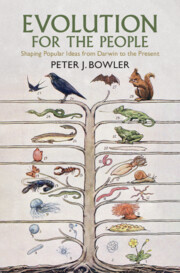Book contents
- Evolution for the People
- Evolution for the People
- Copyright page
- Contents
- Figures
- Preface
- 1 Bridging the Gap
- 2 Before Darwin
- 3 Reacting to the Origin
- 4 Human Ancestry
- 5 Evolutionary Epics
- 6 Challenging Darwinism
- 7 Reconfiguring the Ascent of Life
- 8 Social Evolutionism
- 9 The Evolutionary Synthesis
- 10 Toward the Modern World
- Bibliography
- Index
9 - The Evolutionary Synthesis
Published online by Cambridge University Press: 21 November 2024
- Evolution for the People
- Evolution for the People
- Copyright page
- Contents
- Figures
- Preface
- 1 Bridging the Gap
- 2 Before Darwin
- 3 Reacting to the Origin
- 4 Human Ancestry
- 5 Evolutionary Epics
- 6 Challenging Darwinism
- 7 Reconfiguring the Ascent of Life
- 8 Social Evolutionism
- 9 The Evolutionary Synthesis
- 10 Toward the Modern World
- Bibliography
- Index
Summary
In the 1920s and 1930s the Darwinian selection theory was linked to genetics, providing it with a secure foundation, although wider dissemination of this initiative was limited until the 1940s. Historians note that the ‘evolutionary synthesis’ was a rhetorical device to create an impression of unity, leaving the various disciplines involved still functioning independently. Radio now became an important means of disseminating science news, as in the 1959 celebrations of the centenary of the Origin of Species. The new version of Darwinism eroded the plausibility of eugenics and race theory, although these ideologies remained active in less visible forms. Popular accounts of evolutionism now stressed its open-endedness and played down the old assumption that humanity must be the inevitable outcome of progress. Julian Huxley tried to give the synthesis a moral dimension by linking it to his philosophy of humanism, but creationists saw the new initiative in science as a continuation of Darwinian materialism and renewed their attacks.
Keywords
- Type
- Chapter
- Information
- Evolution for the PeopleShaping Popular Ideas from Darwin to the Present, pp. 217 - 232Publisher: Cambridge University PressPrint publication year: 2024

